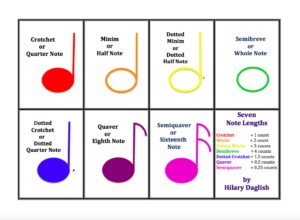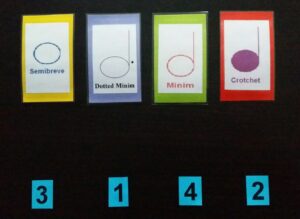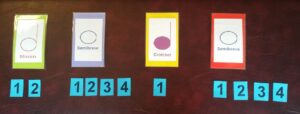When you are reading and playing sheet music on the piano or another instrument you may experience problems with timing and could use some help. Maybe you have just learnt a new note or a new time signature or are struggling with a concept. Read further to find out what some timing problems are and how to solve timing problems. This will enable you to enjoy playing sheet music and your performance to the fullest.
Timing Problems
Here are some timing problems people encounter when playing music.
People:
1. may not understand or remember the note lengths
When you learn a musical instrument you learn note lengths so you produce the desired length of sound as indicated by the composer.
When you learn note lengths you learn the picture of the note which signifies a specific note length and hence the number of counts to play the note for. It is a matter of remembering this in order to play pieces in time.
The picture below represents note lengths from 4 counts or beats to 1/4 count or beat. You learn these in a step by step order.
2. may not remember what
Bar Lines, Bars and Time Signatures are
These are musical terms associated with timing. You need to know them in order to play pieces in time.
3. have counting issues like:
~ not be counting at all whilst playing
When you play pieces it is important to count the note lengths carefully with a steady, even beat.
Some people just forget to count or find it difficult to count and play especially if they are playing a wind instrument.
~ counting unevenly
Some people remember what the note lengths are but do not count evenly and hence the pieces are played out of time.
4. may be thinking about other factors about playing the piece
This includes getting the notes correct, counting correctly, adding musical expression like dynamics. With too many factors to think about timing goes.
5. do not practise slowly
Playing pieces slowly will help you think about the notes, note lengths, counting and other features. The more you play the easier it becomes and hence playing a piece in time.
Strategies to Help Solve Timing Problems
1. Know Your Note Lengths
To help you remember note lengths and solve your timing problems, play your musical instrument whilst looking at the notes on sheet music. You can play exercises and pieces.
Below is the names of the note lengths and how many counts each one is worth.
Please note that counts and beats mean the same thing.
Crotchet = Quarter Note = 1 count
Minim = Half Note = 2 counts
Dotted Minim = Dotted Half Note = 3 counts
Semibreve = Whole Note = 4 counts
Exercises: to reinforce note lengths
You can get help by copying the note length pictures from your tutor book or ask your teacher.
Use the note lengths you have met so far, for example 1 2 3 4 count notes as you see above.
i. Draw – Count – Play
Draw 4 x 1 beat notes. Write the number 1 under each note for a 1 count note.
Draw 4 x 2 beat notes. Write the number 2 under each note for a 2 count note.
Draw 4 x 3 beat notes. Write the number 3 under each note for a 3 count note.
Draw 4 x 4 beat notes. Write the number 4 under each note for a 4 count note
You can also do this with other note lengths you are learning or struggling with.
For each row of notes:
clap and count the beats out loud.
Count 1 for the 1 beat note
Count 1-2 for the 2 beat note
Count 1-2-3 for the 3 beat note
Count 1-2-3-4 for the 4 beat note
play using any note on your instrument and count as above. For piano you can play any key on right hand and then left hand.
Please note that you can count out loud or quietly. Have a go at both ways if you are piano playing.
ii. Create a Rhythm of Different Note Lengths
Draw 8 notes of varying note lengths using the note lengths you know so far.
Write the counting underneath each note, for example, 1 underneath the crotchet or 1 beat note, 1-2 underneath the minim or 2 beat note, 1-2-3 underneath the dotted minim or 3 beat note, 1-2-3-4 underneath the 4 beat note.
Clap and count quietly or out loud if you can.
Play the rhythm on any note of your instrument and count. For piano, play right hand notes and then left hand notes.
Variation:
Create a rhythm using any note lengths with
– 5 notes
– 12 notes
– own number of notes which you decide on
iii. Write down the following note length words and draw the specific note underneath
2 count note 4 count note 1 count note 3 count note
iv. Copy the picture and draw a line from the notes at the top to the correct note value underneath. Click picture for the answer.
2. Know Your Bar Lines, Bars and Time Signatures
Bar Lines:
These are the vertical lines you see on sheet music.
They divide music into equal bars.
A double bar line tells you it is the end of a piece.
Bars: Another name for Bar is Measure.
A bar is represented by the notes and rests between the bar lines.
Each bar has the same number of beats.
Time Signatures:
These are the 2 numbers you see at the beginning of every piece of music.
Beginners start off learning time signatures 4 3 2 C
4 4 4
The top figure tells you the number of beats per bar
The lower figure tells you the type of beat that gets 1 count
So a time signature of 4 means there are 4 one beat notes in each bar
4
C as a time signature means common time and is another way of writing 4
4
Exercise: Do this to help your memory
1. Copy the piece of music
2. Fill in the time signature and write underneath how many beats to each bar
3. Play the exercise on your instrument slowly
3. Know Your Counting Per Bar or Measure
Once you understand and remember what the note lengths, bar lines, bars and time signatures are then you can practise counting the beats per bar to help you keep in time.
So with a piece in 4 time, you count 1 2 3 4 in every bar or measure.
4
Every time you get to a bar line you start the counting at 1 again.
1. Exercises:
Do these exercises 1,2,3 below to get used to counting and to help with the counting problems as mentioned at the start.
For each exercise:
i. Fill in the bar lines
ii. Write the counts per bar underneath each note
iii. Clap and Count out loud
iv. Play and Count
~ out loud on any piano keys with your right hand or left hand or both
or
~ to self on any notes you know on the recorder or flute or other wind instrument
1
2
3
2. Create a Rhythm Using Note Length Cards
To do this you need Note Length Cards.
I have developed some note length cards and games to help with the memory of the note lengths and the confidence to count and keep an even beat. My set consists of the note lengths, time signatures, bar lines and counts.
You can download the e-book of Note Length Cards and Games Here.
Here is a sample page of the Crotchet or 1 count notes.
OR
You can create these yourself by hand or on the computer. Create a set of 4 to 8 cards of each note length you know, like the 1 count example sample page.
A teacher can hand over a set of cards for the student to use within a lesson or a student / do-it-yourself-learner can use their own cards.
Then Create a Rhythm
A teacher can give you criteria using the note lengths you know so far or a student/ do-it-yourself-learner can just decide on the note lengths to use.
For example
Create a Rhythm of ‘X’ number of bars with a time signature of ‘Y’ and the note lengths you know so far. Add bar lines and counting per bar underneath the note lengths.
Let’s be more specific
Create a Rhythm of 4 bars using 4/4 time signature with time lengths of 1, 2, 3, 4 counts. Add bar lines and counting per bar underneath the note lengths.
See how creative you be with your rhythm(s)
Then
- Clap and Count the rhythm, counting per bar.
- Play and Count the rhythm on any note on the piano using the left or right hand or both or on your flute, recorder or other instrument.
4. Learn a Piece One Step at a Time
You have to learn to read the notes and note lengths and then add the other musical features like repeats, dynamics, accents and more.
To help solve timing problems focus on one thing at a time so you don’t get confused with trying to get all aspects correct at the same time.
Here is what you can do
CLAP SAY FINGER PLAY
Rhythm: CLAP SAY
With any exercise or piece you can CLAP the rhythm and SAY the count out loud at first and then in your head.
Look at the simple rhythm to the right. Clap and count out loud.
Keep the beat even across the 4 notes with no gap of time between the notes.
Count Evenly.
Do the same idea with any piece you are learning and playing.
Note Names: FINGER PLAY
Know how to read your notes and locate which keys to press down on the piano or keys or holes to press down on your flute or recorder.
Now FINGER the notes with the correct fingering for the note on your instrument. If you are playing the piano find the best finger number and stick to it each time you play the piece.
Timing with Note Names
When you are comfortable with playing the notes focus on your timing.
And PLAY the notes S L O W L Y whilst counting evenly so you get used to counting in your head or tapping your foot or toe to the beat. If you are not playing a wind instrument then count out loud. I find that this helps a lot of people feel and keep the beat.
As the notes become easier then the timing of these notes become easier with more even counting. If there is a difficult section, pull out and practise separately.Hopefully this will help solve timing problems.
Sometimes people focus on getting the timing correct first and then the correct notes. It does not matter which order as long as you focus on each separately at first.
Other Factors of Piece
Then you can concentrate on the other factors of the piece like dynamics.
5. Play Lots
When you are first playing an exercise or piece:
1. Play slowly:
This helps you get used to the notes and counting of the piece, which is especially good for the non-counters to start counting.
I recommend playing at the speed of the hardest bar or section so the timing of the piece is more likely to be even throughout. This is great for the Uneven Counters. But focus on slow playing. Think of Dancers needing an even beat to dance to or Marching Girls having to keep in time.
2. Count out loud:
I have found with students that most keep better time when they count out loud. Obviously you are unable to count out loud on wind and brass instruments. If the instrument allows you to do it then it is beneficial to do so.
3. Count to self:
You will not be performing your piece with loud counting so get used to silent counting.
4. Use a Metronome or Other External Source
This gives a regular beat and any given speed. Choose a slow speed to begin with and build up the speed as you get used to the even beat and the notes.
The more you play the piece, the easier the notes will be to play and flow more easily in time with even counting.
People who have difficulties with counting need to understand and remember what all the features mean, do the suggested exercises above and play lots using the Learn A Piece One Step At A Time Strategy.
Conclusion
To Help With Your Timing When Playing An Instrumental Piece You Need To
KNOW YOUR:
Note Lengths,
Bar Lines, Bars and Time Signatures,
Counting by Bar or Measure
COUNT CAREFULLY AND EVENLY
LEARN A PIECE ONE STEP AT A TIME
PLAY LOTS
To Help With This
DO EXERCISES AND ACTIVITIES
So whether you are having problems remembering the time lengths or find it hard to count out loud or just like to play your pieces fast without thinking about the timing then hopefully you have some tips to solve timing problems whilst playing music on your musical instrument.
If you have been learning piano on your own and are struggling or you have been playing another instrument and have difficulty in Timing and would like to start learning the piano then This May Benefit You.
If you have any questions or would like lessons to help your timing then please Contact Me Here.


